Updated:
08-Dez-06
ETAMSAS, the new ETON Air Motion
Satellite System
HGP Ronda Measurements (Reference)
Introduction
If you build something new or you
tweak something existing, you want to know the answer on the burning question "and,
how does it sound ??". You can eye-wash yourself by only listening to the new
components or new configuration and start complimenting yourself with jaw-dropping
comments and OH's and AH's on how wonderful it sounds. Know what? in 90% of the cases you
will be right. It actually does sound good. In the hobby where we are all in, most of the
creations (well, some special creations I will NOT comment......... ) simply sounds very
nice and appealing. It is not Black / White. So, where was I? Oh, yeah, building something
new... As I more or less copy an existing loudspeaker system, but with totally different
chassis and filter, you need to compare between old and new. Which in this particular case
is quite apples and apples..... Whatever the difference will be, it will be purely on
chassis and filter. So I will do a lot of listening tests between the 2 sets (I still very
much like the very neutral open sound of the HGP combined with the easiness this speaker
produce MUSIC) whilst tweaking around with the ETAMSAS filter.....
BUT: I also like to understand what I
am actually doing and what the physics behind the perceived sound characteristics are !!
Therefore I bought the HobbyBox software and the microphone didn't I ?? Yes, I did ! So
the first step was, logically, to measure the existing system and have that ready to
compare with the ETAMSAS. I want to be able to make correlation's later on. Like:
"Ohh, the Etamsas sound more warm (or something). I want to be able to read this from
the HobbyBox graphs so that when tweaking: "MMHH, when I change this value in
the filter (for example) I get thinner vocals" I hope to see a clear change in the
frequency graph or what ever. That is the background for this whole exercise and it makes
it MUCH MORE FUN, doesn't it ??
HPG Ronda: The Results of the
HobbyBox measurements
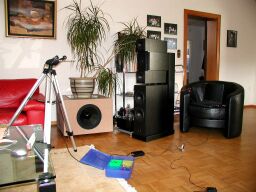 On the picture at the left you see how I have been measuring.
Exactly 1,00 (one) meter distance from the Loudspeaker (now SUB Woofer active by the way).
This results in absolute SPL values in dB as the whole thing is calibrated (HobbyBox has
tools included for that purpose). I also have chosen to measure at the actual position of
the loudspeaker as this is how I listen music. But to be honest, I do not think it makes a
huge difference, as the speakers are positioned away from any walls. Any way, I will keep
this consistent for the rest of the measurements. May be later on, just for fun, I will do
a measurement in the Garden (almost like a dead room) and see what comes out.
On the picture at the left you see how I have been measuring.
Exactly 1,00 (one) meter distance from the Loudspeaker (now SUB Woofer active by the way).
This results in absolute SPL values in dB as the whole thing is calibrated (HobbyBox has
tools included for that purpose). I also have chosen to measure at the actual position of
the loudspeaker as this is how I listen music. But to be honest, I do not think it makes a
huge difference, as the speakers are positioned away from any walls. Any way, I will keep
this consistent for the rest of the measurements. May be later on, just for fun, I will do
a measurement in the Garden (almost like a dead room) and see what comes out.
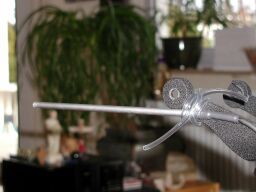 At the right
again a nice picture of the home made microphone. This thin tubular shape guarantees
minimum reflections from the microphone and the tri-pod itself. As you can see, I used a
special kind of audiophile treated plastic tube to have the microphone mounted completely
acoustically decoupled from the tri-pod. It is not cheap, but worth every €uro spent!
You can buy this only from special Audio Accessories stores for aprox 148 €uro per
10cm. Ok, every one still there? Jaw back to it's original position please; who actually
believes this kind of crap, please get yourself another hobby, or keep reading the regular
audio magazines......... hahaha !!!
At the right
again a nice picture of the home made microphone. This thin tubular shape guarantees
minimum reflections from the microphone and the tri-pod itself. As you can see, I used a
special kind of audiophile treated plastic tube to have the microphone mounted completely
acoustically decoupled from the tri-pod. It is not cheap, but worth every €uro spent!
You can buy this only from special Audio Accessories stores for aprox 148 €uro per
10cm. Ok, every one still there? Jaw back to it's original position please; who actually
believes this kind of crap, please get yourself another hobby, or keep reading the regular
audio magazines......... hahaha !!!
Ok, let get some boring facts. Below
graph is the impedance curve. As you see NOT bad at all. Max impedance is 13 Ohms round
1kOhm. Never the less, with a Tube amplifier, you will have more output here, compared to
the rest of the spectrum, simply because the Zout is relative high. Or the damping factor
low, as you will.... The dip to 3 Ohm in the low/mid is typical for a "4 Ohm"
system and is no problem, if (and only when IF !!) your output transformer is designed for
this !! You can also see the 2 little peeks, typical for an bass reflex system
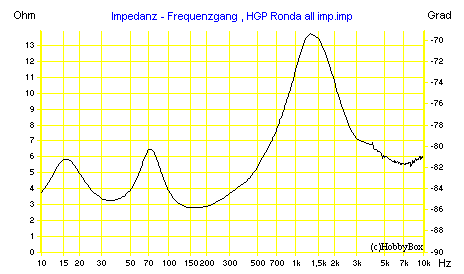
Reading the graph below
is interesting: The black curve is the low/mid section, the Green the tweeter and RED is
the whole speakerbox. Till 3kHz a very smooth curve I must say !! Than we start to see
some hick ups. I think I recognize them as well. How satisfied I may be with the HGP's
they are simply sharp sometimes (well, well, "sharp, come on...) OK, relatively harsh
than? Hard to describe, but a voice or violin can have this little edge round it. Which I
think is the peek from the tweeter at 3,5 kHz and the typical cone break up at 4,5 kHz.
That this prominent cone break up is NOT filtered away is just a cheap thing from HGP, not
good !! For the rest it looks ok. At very high frequencies some tilt and little wrinkles
round 10 kHz, but I do not care. May be on a transistor amp it could be overkill, but at
the end of the day, you can like or dislike a present loudspeaker. KEF lovers will most
likely not like this........
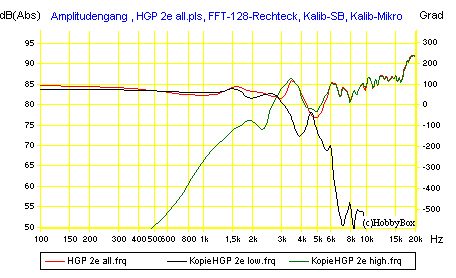
Finally the Waterfall
diagram. This interesting (calculated) graph can tell a lot about the impulse response and
behavior of the speaker ! The ideal situation is,that after a pulse is given to the
speaker (that is the curve at the back of this graph at 0,0 ms) the speaker stops
IMMEDIATELY producing sound. You will understand that this is physically not possible.
After all, if you break your car, you won't stop it within the next 10cm or so (thank
goodness, if this would be the case, my brains would be spread out over the
dashboard............ahem) BUT: a Porsche or F1 car does come to a stop MUCH faster than a
"normal" car. The same with loudspeakers. Good speakers stop quicker AND have
better control. The control thing you can see from the small spikes. This is a sign of
oscillating ringing of the membrane, which is living its own life for a couple of ms. The
more the worse......... Well, again till 3kHz, this is actually a VERY good speaker. Than
I see some wrinkles at the earlier mentioned frequencies. It is not THAT bad, but they are
existing and do influence the sound reproduction. If you compare with the waterfall graphs
from the (still unfiltered !!) ETON units (filter section)
they (pffffffff) score better in the mid/high frequency range. So I expect a cleaner
sound. Lets wait and see...
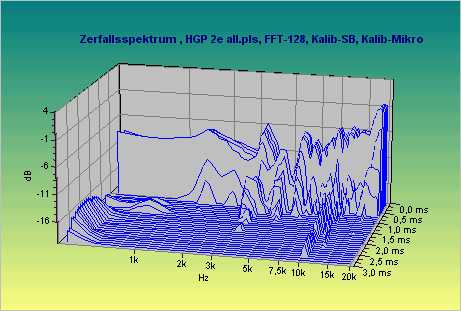
Happy Listening and Building
!!!!
Doede Douma
IMPORTANT:
The information provided on this page is intended as guide for DIY activities and
therefore free to copy and or publish. If any one wishes to use any of the information
from my WEB site, please make sure to refer and footnote to my URL Link as source! Doede
Douma
 On the picture at the left you see how I have been measuring.
Exactly 1,00 (one) meter distance from the Loudspeaker (now SUB Woofer active by the way).
This results in absolute SPL values in dB as the whole thing is calibrated (HobbyBox has
tools included for that purpose). I also have chosen to measure at the actual position of
the loudspeaker as this is how I listen music. But to be honest, I do not think it makes a
huge difference, as the speakers are positioned away from any walls. Any way, I will keep
this consistent for the rest of the measurements. May be later on, just for fun, I will do
a measurement in the Garden (almost like a dead room) and see what comes out.
On the picture at the left you see how I have been measuring.
Exactly 1,00 (one) meter distance from the Loudspeaker (now SUB Woofer active by the way).
This results in absolute SPL values in dB as the whole thing is calibrated (HobbyBox has
tools included for that purpose). I also have chosen to measure at the actual position of
the loudspeaker as this is how I listen music. But to be honest, I do not think it makes a
huge difference, as the speakers are positioned away from any walls. Any way, I will keep
this consistent for the rest of the measurements. May be later on, just for fun, I will do
a measurement in the Garden (almost like a dead room) and see what comes out. At the right
again a nice picture of the home made microphone. This thin tubular shape guarantees
minimum reflections from the microphone and the tri-pod itself. As you can see, I used a
special kind of audiophile treated plastic tube to have the microphone mounted completely
acoustically decoupled from the tri-pod. It is not cheap, but worth every €uro spent!
You can buy this only from special Audio Accessories stores for aprox 148 €uro per
10cm. Ok, every one still there? Jaw back to it's original position please; who actually
believes this kind of crap, please get yourself another hobby, or keep reading the regular
audio magazines......... hahaha !!!
At the right
again a nice picture of the home made microphone. This thin tubular shape guarantees
minimum reflections from the microphone and the tri-pod itself. As you can see, I used a
special kind of audiophile treated plastic tube to have the microphone mounted completely
acoustically decoupled from the tri-pod. It is not cheap, but worth every €uro spent!
You can buy this only from special Audio Accessories stores for aprox 148 €uro per
10cm. Ok, every one still there? Jaw back to it's original position please; who actually
believes this kind of crap, please get yourself another hobby, or keep reading the regular
audio magazines......... hahaha !!!

